A Stunning Depiction of the Last Supper
Tintoretto's artistic insight into the supreme gift of Christ in the Holy Eucharist
Jacopo Robusti, otherwise known as Tintoretto (1519–1594), may not be a household name like Rembrandt or Van Gogh, but, as is the case with so many great artists, he ought to be—especially for believers who may rejoice in and learn from his exquisite art, which he placed in service of the mysteries of the Christian Faith.
Tintoretto was a pupil of Titian in Venice, albeit short-lived in that capacity. The story is told that the older Titian quickly recognized what a gift his pupil had, and in the competitive spirit of Renaissance workshops, kicked him out lest he learn too many of the master’s secrets and rival him. The precaution was in vain, as the pupil was capable of learning on his own.
In his works, there tends to be a certain moodiness of atmosphere, often a dark shadowy feel that serves as the dramatic backdrop to the manifestation of divine light. One sees similar effects in El Greco’s work. On the narrative and compositional surface, Tintoretto’s paintings tend to be busy, even chaotic, yet they possess an underlying sense of calm, a supernatural gravity—as if the hidden hand of divine Providence is holding together the variety of persons, objects, and activities, ordering them to the manifestation of His glory (for indeed, this is the case, and art at its best helps us to see further into reality than the unaided, untutored eye can do).
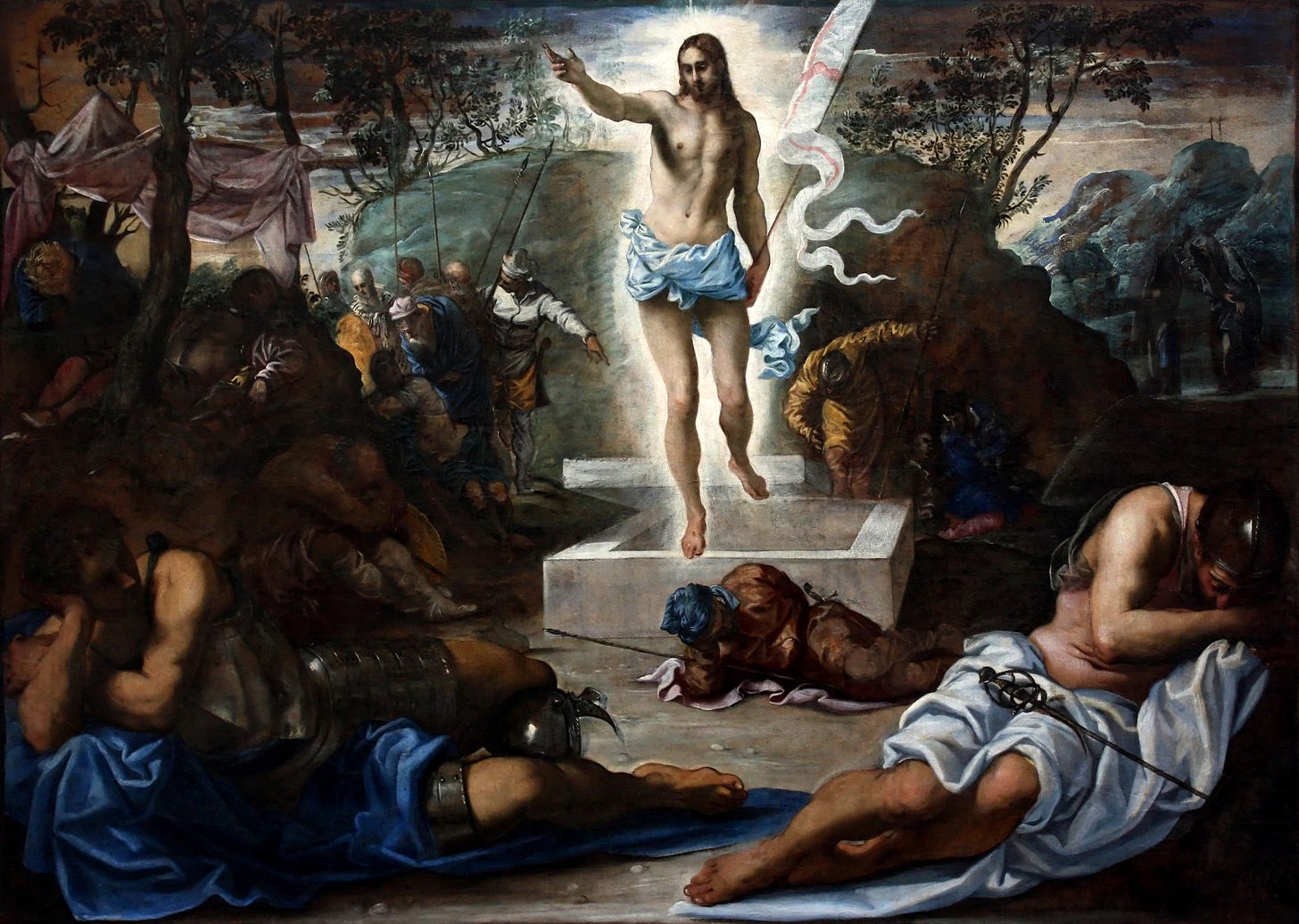
We see these qualities magnificently displayed in Tintoretto’s final and greatest depiction of The Last Supper, completed in 1594, the year of the painter’s death, and located beside the high altar of the Church of San Giorgio Maggiore in Venice.1
The last meal of Our Lord’s mortal life had, of course, already been painted countless times by earlier Renaissance artists, who helped themselves to large doses of poetic license by placing the event in broad daylight, often outdoors, or in a tidy geometrical space. We see this kind of approach in, for instance, Andrea del Castagno’s Last Supper of c. 1447:
Under the influence of mannerism, Tintoretto approaches his subject quite differently. For him, the Last Supper is the ultimate chiaroscuro of good and evil. Set within a dark space illuminated primarily by a more-than-ordinarily potent oil lamp in the top left, the supper is a swirl of motion and revelation, as the Lord, standing in the center, feeds the Apostle to His right with His most sacred Body. (As is seen in many paintings of the Last Supper, Jesus is placing the Eucharistic morsel directly into the apostle’s mouth, which is implied in the Jewish custom of dipping bread into wine before consuming it—a form of intinction practiced to this day by Eastern Christians.)
The halo around Christ’s head stands at the very center of the painting, as if to say: Here indeed is the true light of the world, the light that shines in the darkness, a light the darkness has not overcome, in spite of its best efforts. The Lord is dressed in a red tunic with a blue outer garment, colors that Tintoretto’s contemporaries might have connected with their use in The School of Athens by Raphael: red for fire, and blue for its opposite element, water—symbols alike of divine love and divine judgment.
The apostles—those who are in a state of grace—are recognizable in the eleven gently illuminated heads. Gone are the awkward early medieval disc-haloes that one-point perspective had converted into saucers or platters; in their place, a soft play of supernatural light around their otherwise shadowy countenances.
The apostle to the Lord’s left gazes contemplatively. Other apostles gesticulate, lean over, rise up, gripped in anxiety about the treachery, provoked to wonder by the mystical supper. The apostle nearest to the viewer even motions to a beggar to stop bothering him, as there is something more important to pay attention to:
In keeping with an artistic convention, Judas is the only disciple depicted sitting on the opposite side of the table, dressed in better garb than the others—in fact, in a garb remarkably like that of a Cardinal—with a hand gesture that suggests detached, critical commentary, as if theorizing at a Synod about new rules for communion.
Meanwhile, a number of waiters busy themselves with food, drink, and dishes, seemingly oblivious to the unfolding of the new and everlasting covenant.2 How sharply it should pierce us when we think of the indifference and apathy of so many in our world to this ultimate manifestation of divine love that occurs every day throughout the world!
Wherever the sacred mysteries of the Body and Blood of our crucified and risen Savior are celebrated, there are, to be sure, some on the inside like the eleven and some like Judas, but many more on the outside, preoccupied servants intent on their worldly business, blind to the light shining from the face of Christ. In fact, some behave like the cat in the lower middle of the painting—an irrational animal whose only appetite is for material food.
Tintoretto, like Dante, tours us through heaven and hell: we see holiness, active and contemplative; we see malice; and we see the lukewarm absence of either.
But perhaps the most wondrous touch of all in this painting is Tintoretto’s lifting for us of the veil separating the invisible realm from the visible, showing hosts of angels surrounding the Son of God, giving Him the homage that is His due. Spirits from the realms of light, they bring their own luminosity with them into a darkness to which they are impervious. They are like living flames of love, fully awake and alert to the meaning of what is taking place in the Heart of Jesus, in His hands, in this feast that anticipates and symbolizes the bloody sacrifice of Calvary on the morrow, which opens the way to the heavenly wedding feast of which the angels already partake:
Let’s step back again and view the work as a whole:
As an artist working in the full swing of the Counter-Reformation (this painting was completed about thirty years after the close of the Council of Trent), Tintoretto thought very carefully about the placement of this gigantic painting (144”× 224”, that is, about 12’ by 18’8”) within the church as he planned out the contents:
The canvas is placed on the right wall of the presbytery—the sanctuary of the church that physically separates the nave, where the congregation sits during Mass, from the monk’s choir stalls behind the main altar…. The markedly oblique angle of Tintoretto’s composition suggests and indeed establishes a connection between the painted table and the stone altar table…. Tintoretto conceived a picture that can be seen simultaneously from two possible angles and, most importantly, from two different sets of viewers. Sitting in the nave, the faithful look at the painting to their right and find themselves in front of the table, witnessing the apostles’ communion as Christ administers the Eucharist and institutes the Mass (the aspergillum and pyx on the small side table on the foreground serve to emphasize that association). At the same time, looking from behind the altar, the monks find the Last Supper to their left and almost feel they are sitting at Christ’s table, next to the apostles.3
The whole painting is therefore a catechism, and this, at two levels: dogmatic and moral.
On the dogmatic level, it asserts the unity of the Last Supper, the sacrifice of Christ on Good Friday, and the offering of the Holy Sacrifice of the Mass. These, as the Council of Trent defines, are one and the same, with the manner of offering alone differing: in a bloody manner on the cross, and in an unbloody manner the night before, and ever afterwards. The continuity of the physical altar of San Giorgio with the table of the painting, and the visual line that extends outward to the congregation, passing by the implements of the Mass—the aspergillum for the Asperges and the pyx for Communion—are subliminal reminders of this crucial truth, denied by the Protestants.
On the moral level, the painting is a catechism on sight and blindness. What is it that we see when we attend Mass? What would we have seen at the Last Supper, or at the foot of the Cross? Do we see with the eyes of faith the glory of the Son of God, sacrificed for our sins, risen for our salvation, offered at the altar for our lifelong redemption, fed to us for our pilgrimage to eternity? Do we profess and believe in this light shining in the darkness of the world that threatens to engulf us, and in the chiaroscuro of the Church on earth made up of saints and sinners? Where, in which part, under which character, are you and I located in this bustling scene of liturgy and life?
In what follows, I will sometimes use images that have been lightened in order to bring out the details.
I say seemingly, because one might perhaps imagine them as disciples who wait on the tables—much as Jesus Himself, after the Supper, will take off His garments and stoop to wash the apostles’ feet.
From an article on the SaveVenice website.



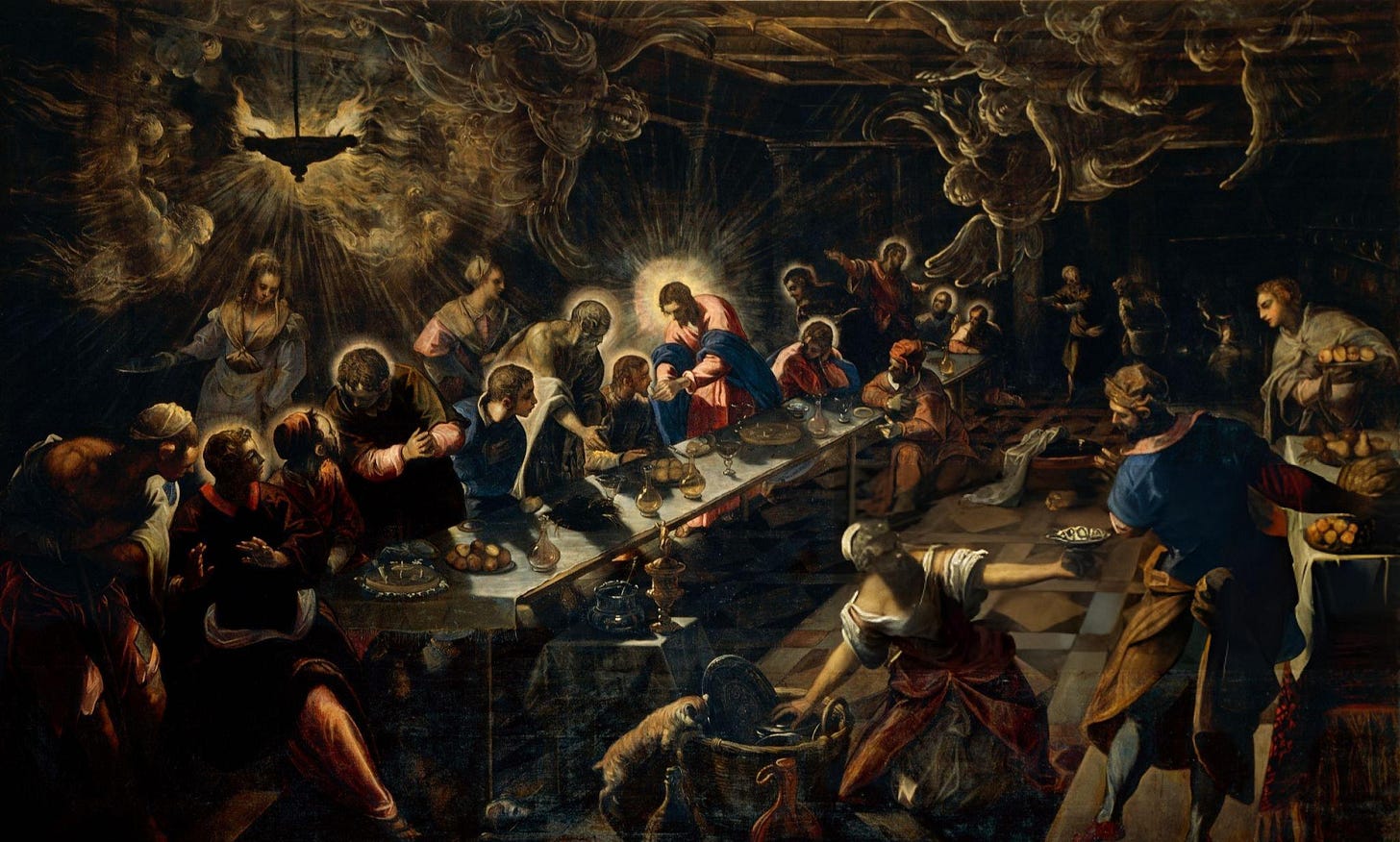



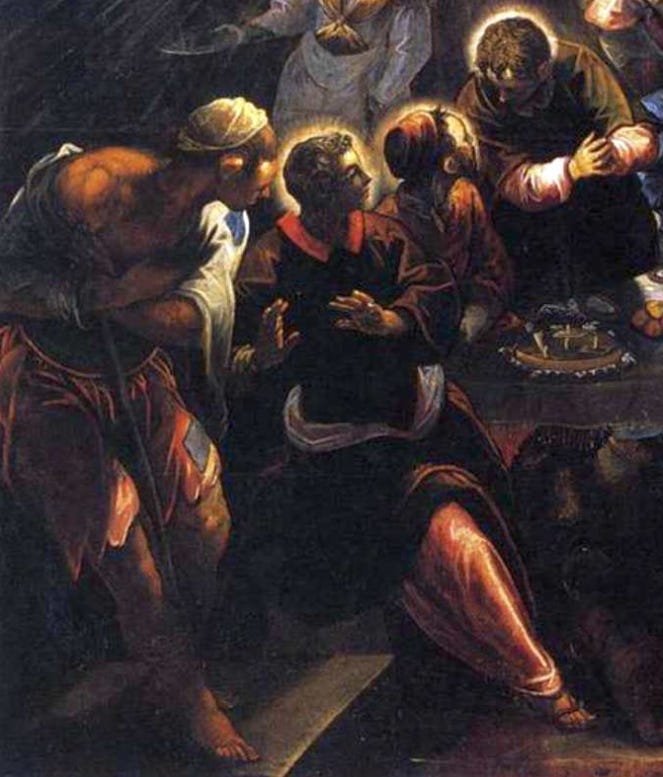

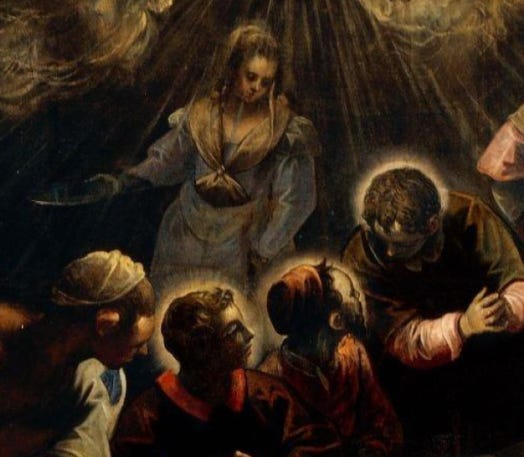

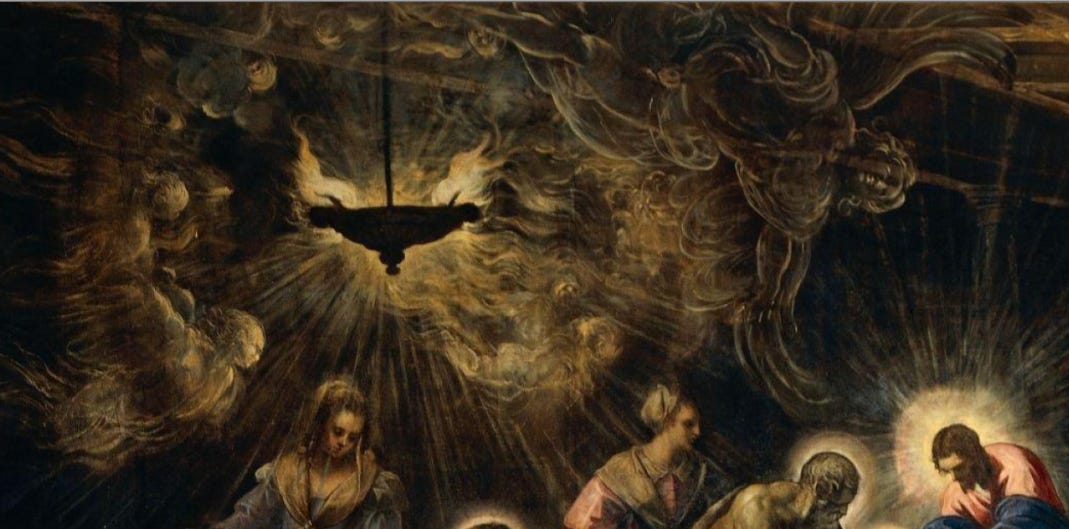


Dr. Kwasniewski, I have listened to this three times and then went back to read the article and look at the pictures. For me it is a meditation. Your lines are thought provoking. It is a study for our times, right up to Judas, the cardinal who misses the point entirely of the Holy Mass, thinking about “new rules for Communion.” The depiction of the angels, who are adoring at every Mass is a good reminder of this heavenly reality often forgotten. Seeing Tintoretto’s work in a moral and dogmatic light is brilliant especially after the Council of Trent. Historical context is equally important. I’m still dealing with Protestant siblings and praying some day they, along with those in the Church, will lose the darkness. Finally, I myself needed these reminders to focus on the unbloody Sacrifice in a turbulent world, an endless reminder of His Love that He left for us.
Dr. K; Thanks for another powerful lesson in the majesty of Catholic art! I had never heard of the artist so I thank you. A reproduction of that would be wonderful to have!